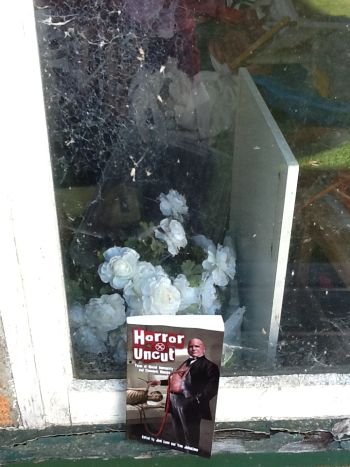
Another review from the reviewer living in Clacton-on-Sea:
Horror Uncut: Tales of Social Insecurity and Economic Unease
Edited by Joel Lane and Tom Johnstone
Gray Friar Press 2014
I have just received my purchased copy of this book, including stories by
Joel Lane,
Simon Bestwick, Priya Sharma, John Llewellyn Probert, Stephen Hampton,
Gary McMahon, Anna Taborska,
John Howard, Laura Mauro,
Stephen Bacon, David Williamson, Rosanne Rabinowitz, John Forth, David Turnbull, Alison Littlewood, Andrew Hook, Thana Niveau.
My previous reviews of Gray Friar Press books linked from
HERE.
I intend to conduct a real-time review of this book in the comment stream below as and when I happen to read it…
Like this:
Like Loading...
Tagged as
Alison Littlewood,
Andrew Hook,
Anna Taborska,
David Turnbell,
David turnbull,
David Williams,
David Williamson,
Gary McMahon,
Gray Friar Press,
Joel Lane,
John Forth,
John Howard,
John Llewellyn Probert,
Laura Lauro,
Laura Mauro,
Priya Sharma,
Rosanne Rabinowitz,
Simon Bestwick,
Stephen Bacon,
Stephen Hampton,
Thana Niveau,
Tom Johnstone
-
-
Pieces of Ourselves by Rosanne Rabinowitz
“His gaze settles on a stone box on the top shelf. It’s made of smooth grey stone, inlaid with patterns…”
This is a substantive exquisition: stemming from a believably experienced cuts demo and its resultant police ‘kettle': serendipitously blending, inter alia, Bestwick’s earthstone holes with flesh as bodies and Williamson’s every cut is another bodily destructuring toward whole-‘sale’ vanishment, but here Rabinowitz’s work — of accretively obsessive, self-harming shavings and skeins of skin from the male protagonist’s body and the memento stone box where he collects them — becomes a highly sensitised vision of something beyond the cuts, a vision that rationalises the demos and fights against the cuts as part of a pattern of his past life, austerity further pared, his exes, his travels, his thwarted ambitions, the patchwork people, his “Feeling bolder”, a sometimes clear, sometimes confused vision that enticingly is the potential core of the horror uncut ‘book bloc’. For me, the Platonic Form of Library. Or a shimmering Mauro wing. Flecks on marble.
-
-
A Simple Matter of Space by John Forth
Scene: Housing Department office safety screens, behind which housing officers sit. An elderly Leibniz complains to one of them about the bedroom tax, the empty space left by the elapsing of his wife… a loss that not only leaves a void in his life but also in his pocket, in his house, in his universe. There ensues a very effective cataclysmic Baconite Exodus-gulf blood-and-guts scene when Leibniz returns the space to the Housing office, space that implodes and explodes no doubt in accordance with the philosophy of physics of his famous namesake. This constructively contrasts with the equally powerful subtlety of the Rabinowitz story that is directly contiguous with it…
It is not the satire or irony of Probert, Taborska and others. It is a full-blooded defiance ad absurdum, ad infinitum, and all the healthier for it.
-
-
The Privilege Card by David Turnbull (David Turnbell in contents list) – but Tom Riley is more of a turncoat, I guess, against his own father’s socialist ideals, when he accepts a rewards card for snooping and culling on behalf of the authorities for his own benefit. This is a satirical Horror SF concept with a Ghost Story aspect where the father comes back to haunt Tom’s conscience, complete with the ‘tumour leeches’ that killed him. Not sure how these leeches fit in with this fable’s moral at the end. Had his father been a filthy Capitalist on the quiet? I am afraid that none of the horror, ghost and satire aspects worked for me. The SF concept was quite intriguing, though.
-
-
The Ghost at the Feast by Alison Littlewood
“Coleman’s real name wasn’t Coleman. It seemed to be the fashion these days for MPs to adopt a name to match their principles, or to mask them,…”
A beautifully written SF type extrapolation to match the earlier Privilege Card and the Leibniz bedroom-tax ‘space’, here the Square Footage Tax, where footsteps are measured out in despair or hollowness. A successful ghost story, too, truly haunting, and taking Forth Leibniz’s ad absurdum, ad infinitum defiance, but here toward an apocalyptic but delicately inscrutable, even apolitically didactic, finale.
“Despite the haze across his eyes he could see that the stone was mellow and beautiful in the afternoon sun,…”
-
-
The Opaque District by Andrew Hook
Another inscrutably beautiful treat to follow that of Littlewood, the two stories’ endings perfectly complementing each other. This one is a classic of our downtrod times, with its living prehensile queues (negatively symbiotic queues queuing queues) along rejigged shopping parades mentioned earlier in this review, all pared – like Rabinowitz’s skeins of skin – ‘back to basics’. Yet there is the metaphor beyond the graffiti mural, one that resonates with the impermeable stone of this book’s gestalt but also with its Exodus gulf, with the initial promise of light and freedom from the ‘shuffling’ and the
“threadbare ‘bag for life'”. Whether or not a false promise, it is for you to decide if this protagonist ever left the queue.
A graffiti mural I photographed in the opaque ukipness of Clactonia a week or so ago:

-
-
No History of Violence by Thana Niveau
“Most people took their sanity for granted, never knowing how awful it could be to have to fight for it, gaining ground inch by torturous inch.”
…like those measured steps of Littlewood, upon the stony ground that is existence. I started this story with some trepidation, wondering if it might disrupt the mood built up by the previous two stories, but, as it turned out, this is the perfect coda, where I shall mention Ligottianism and Anti-Natalism surprisingly for the first time in this review. And its ending is powerful and cruel, so much so it even lends hope that, if the parasites are real not imaginary, then they can be killed. That cry for help now answered?
The book is a whole experience, one that is an unmissable landmark, I believe, in a certain form of ostensibly didactic literature that actually works beyond its own didacticism. I shall now read the book’s Afterword by Tom Johnstone that may give me more food for thought but, as ever, I only review fiction.
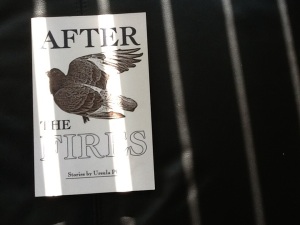


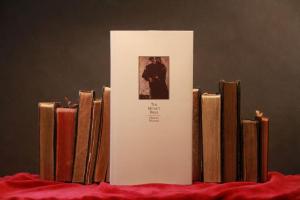


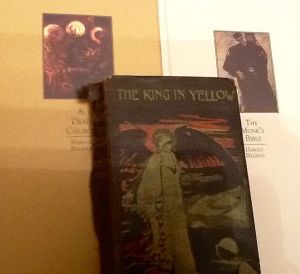
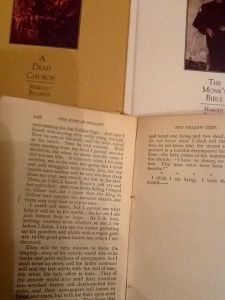
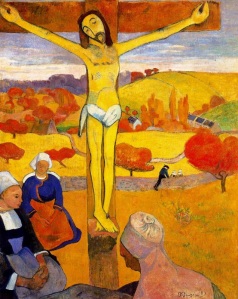





“Before Mum died she used to forget things all the time. I can’t remember what it was that killed her in the end.”
Dear U, A series of letters from one to another, the same writer and the same recipient, with no intervening replies, giving a rhythm of meaning, a rhythm of life being collected together, about ‘rodents’ that came to check up on us, about the the clutter, about the surfaces upon which the letters are written, the other people named in that deadpan or oblique rhythm, and the tree or more than one tree with these letters about them … or on them. Love, Des.
ps: the last book of yours I read was fronted with a story with ‘water’ in the title unless my own memory has already lapsed at last.
A cigarette in another story, or a U for Umbrella or Ursula? This is a patchwork story that conveys life as a patchwork of relationships, feeling engulfed by a grey whale, times are hard, jobs hard to get, but a wry humour is a hope of a post-modern art hindsight that makes life something worth experiencing? I loved this story and can’t do justice to it.
Impulsively, earlier today, I had this slight caricature made of me in a slot-machine booth on an empty Clacton pier (it was too early in the day for ordinary weekday visitors to be walking on the pier in October)… It cost me two pound coins which I now feel rather guilty about.
“People mill about as though it was the last day on Earth, as though there are no longer any jobs to go to, as though, at last, they can do anything they like.”
…as though the ice is melting, and this work is a sinuously fluid symphony of blending inverse, often cynical, anthropomorphisms of men, plus general skin colours as well as prime colours, genders, sexual orientations, friendships… While wielding the moon… Surely, the Apotheosis of the Pflug.
“In the bath she looks at her submerged body, confused,…”
“people in the television could never see him, / they just told him news of the war.”
Broken by cannibalising enjambment, this is a very disturbing work where the Pflug fluid identity tropes, as I have come to know and love them, emerge, pass and re-emerge, like the same war does, in a Toynbeean backdrop of rhythm to a human challenge and animal response.
“Paper airplane pen pals.”
…our grandmothers in a residential microcosm with several floors, even basement windows looking out upon inner pipe work. Top floor people, middle floor folk, lower floor, too, all vying their place or accepting it, and two of us with dinner parties between like up and down Caleb Wilson’s Scree elsewhere. This is my favourite Pflug story ever. Top story.
“I showed you all my old books that I’d collected in my travels, some with the paths of worms etched in their pages like scribbled hieroglyphics. / What do worms know? / Enough to eat books.”
Like the previous story, the Pflug world is a house or a home, here a sororal Alembic between stories or a theosophical one with a ‘guide’, a guide who is a reviewer or a character in the story?
“They didn’t have multicoloured push pins in clever geometrical shapes back then, Pinka thought,”
A marvellously substantive story about a para-cultural ambiance that one may call the Isis State, where Pinka works for an ornament firm, good at apportioning baubles on a Christmas Tree, but taken back and forth by a microcosm of a commune of friends and colleagues, who drift or focus by turns, conversing with each other, loving each other, sexing each other, in permutations, with roleplaying visions of Egyptian deities as a form of telepathy. Or real deities as a form of a real alternate world.
“And as they left the dawn lit streets to climb the stairs to the third floor, dragging themselves, wishing for once they lived on the second floor and not the airy eyrie of the third,…”
A baby under the borage, this is a dreamily stoical tale of a smelly abandoned woman, undrowned by possessions, helped by an equally stoical fishing-hole man, without intentions, and by whatever help she could get to go shopping. It is extremely haunting, poignant, and I am beginning to see \ what I should have already seen, by dint of the many stories I have by now recently read by Pflug, i.e. that she is a major short story writer albeit one where, I sense, many readers have not yet crossed that retrocausal \watershed.
Not that I am claiming any special critical perspicacity, but only luck from dreamcatching books.
Red Velvet Dust
“In fire shadow Chelsea imagined there were birds, little swallows cut from paper and hung there, thousands of them, like the origami cranes she and Esther and Julie decorated their tree with at Christmas. Who had done that? Cut out and folded all those little birds, hung willows with them?”
Pinka? But I, too, tinily helped hang a willow with them – and later became the willow tree itself? This story I obviously first read in 2007, and I can’t remember reading it since then, and today I feel I see so much more in it, but I saw a helluva lot in it then, so now it bursts with meaning, teems with it…and it sheds new meaning on much else I have read by this author in recent weeks: vice versa, too. I am too close to it to comment further. But, just as one of many aspects of this story, I have today been able to refresh how to blend already departed people with their continued presence, also how to blend people who have not yet departed with the promise of their future presence. Even self with self. Story with story.